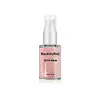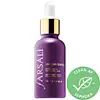What's inside
What's inside
 Key Ingredients
Key Ingredients

No key ingredients
 Benefits
Benefits

 Concerns
Concerns

 Ingredients Side-by-side
Ingredients Side-by-side

Water
Skin ConditioningPropanediol
SolventPolysorbate 20
EmulsifyingTamarindus Indica Seed Polysaccharide
Skin ConditioningRhizobian Gum
Orobanche Rapum Extract
Skin ProtectingXylitylglucoside
HumectantAnhydroxylitol
HumectantXylitol
HumectantSodium Hyaluronate
HumectantSodium Benzotriazolyl Butylphenol Sulfonate
UV AbsorberAcrylates/C10-30 Alkyl Acrylate Crosspolymer
Emulsion StabilisingCalcium Aluminum Borosilicate
Titanium Dioxide
Cosmetic ColorantSilica
AbrasiveAmmonium Acryloyldimethyltaurate/Vp Copolymer
Sodium Hydroxide
BufferingPhenoxyethanol
PreservativeEthylhexylglycerin
Skin ConditioningParfum
MaskingIron Oxides
Tin Oxide
AbrasiveCI 17200
Cosmetic ColorantCI 19140
Cosmetic ColorantWater, Propanediol, Polysorbate 20, Tamarindus Indica Seed Polysaccharide, Rhizobian Gum, Orobanche Rapum Extract, Xylitylglucoside, Anhydroxylitol, Xylitol, Sodium Hyaluronate, Sodium Benzotriazolyl Butylphenol Sulfonate, Acrylates/C10-30 Alkyl Acrylate Crosspolymer, Calcium Aluminum Borosilicate, Titanium Dioxide, Silica, Ammonium Acryloyldimethyltaurate/Vp Copolymer, Sodium Hydroxide, Phenoxyethanol, Ethylhexylglycerin, Parfum, Iron Oxides, Tin Oxide, CI 17200, CI 19140
Water
Skin ConditioningPropanediol
SolventGlycerin
HumectantPolysorbate 20
EmulsifyingGlyceryl Polyacrylate
Euterpe Oleracea Fruit Extract
Vaccinium Angustifolium Fruit Extract
Skin ProtectingLycium Barbarum Fruit Extract
AstringentSambucus Nigra Fruit Extract
AstringentTamarindus Indica Seed Polysaccharide
Skin ConditioningPhenoxyethanol
PreservativeEthylhexylglycerin
Skin ConditioningHydroxyethyl Acrylate/Sodium Acryloyldimethyl Taurate Copolymer
Emulsion StabilisingVanilla Planifolia Fruit Extract
Skin ConditioningCitrus Aurantium Bergamia Fruit Oil
MaskingCitrus Paradisi Peel Oil
MaskingCI 17200
Cosmetic ColorantCI 14700
Cosmetic ColorantBlue 1 Lake
Cosmetic ColorantMica
Cosmetic ColorantTitanium Dioxide
Cosmetic ColorantWater, Propanediol, Glycerin, Polysorbate 20, Glyceryl Polyacrylate, Euterpe Oleracea Fruit Extract, Vaccinium Angustifolium Fruit Extract, Lycium Barbarum Fruit Extract, Sambucus Nigra Fruit Extract, Tamarindus Indica Seed Polysaccharide, Phenoxyethanol, Ethylhexylglycerin, Hydroxyethyl Acrylate/Sodium Acryloyldimethyl Taurate Copolymer, Vanilla Planifolia Fruit Extract, Citrus Aurantium Bergamia Fruit Oil, Citrus Paradisi Peel Oil, CI 17200, CI 14700, Blue 1 Lake, Mica, Titanium Dioxide
Ingredients Explained
These ingredients are found in both products.
Ingredients higher up in an ingredient list are typically present in a larger amount.
Ci 17200 is a synthetic reddish-purple dye.
Ethylhexylglycerin (we can't pronounce this either) is commonly used as a preservative and skin softener. It is derived from glyceryl.
You might see Ethylhexylglycerin often paired with other preservatives such as phenoxyethanol. Ethylhexylglycerin has been found to increase the effectiveness of these other preservatives.
Phenoxyethanol is a preservative that has germicide, antimicrobial, and aromatic properties. Studies show that phenoxyethanol can prevent microbial growth. By itself, it has a scent that is similar to that of a rose.
It's often used in formulations along with Caprylyl Glycol to preserve the shelf life of products.
Polysorbate 20 is made by combining ethoxylation of sorbitan, ethylene oxide, and lauric acid. It is a mild cleansing agent, surfactant, and emulsifier.
As a surfactant, it helps collect dirt and oils for washing. Emulsifiers prevent oils and water from separating.
Polysorbate 20 also adds scent to a product. Since it is made using sorbitol, it has a sweet scent. Sorbitol can also be found in fruits such as apples and peaches.
The lauric acid used to create Polysorbate 20 is often derived from coconuts.
Polysorbate 20 may not be fungal acne safe.
Learn more about Polysorbate 20Propanediol is an all-star ingredient. It softens, hydrates, and smooths the skin.
It’s often used to:
Propanediol is not likely to cause sensitivity and considered safe to use. It is derived from corn or petroleum with a clear color and no scent.
Learn more about PropanediolWe don't have a description for Tamarindus Indica Seed Polysaccharide yet.
Titanium dioxide is a mineral UV filter widely used in sunscreens and cosmetics.
It is one of only two UV filters officially classified as “mineral” by regulatory agencies, the other being zinc oxide.
Titanium dioxide provides broad-spectrum protection mostly in the UVB and UVAII range, with some protection in the UVAI range.
While its UVA protection isn’t as strong as zinc oxide’s, the difference is minor.
A common myth is that mineral UV filters reflect UV light. However, modern research shows titanium dioxide absorbs UV radiation like chemical filters (~95% absorption & 5% reflection).
Thanks to its non-irritating nature, titanium dioxide is suitable for sensitive, acne-prone, or redness-prone skin. It is unlikely to cause "eye sting" like other sunscreen ingredients.
A major drawback of this ingredient is its white cast and thick texture. This is why mineral sunscreens often leave a white cast and are less cosmetically elegant than chemical/hybrid sunscreens.
To improve white cast and spreadability, micronized or nano-sized titanium dioxide is often used.
There are ongoing concerns surrounding nano-titanium oxide's impact on marine ecosystems.
There is no conclusive evidence that any form of titanium oxide (or any other sunscreen ingredients) will cause harm to marine ecosystems or coral reefs. The science is still developing but many consumers are keeping a close eye on this issue.
Please note, many destinations have reef-safety sunscreen rules. For instance, the U.S. Virgin Islands advises all visitors to use non-nano mineral sunscreens.
Nano mineral sunscreens once raised safety concerns about absorption into skin.
Extensive research has shown that they do not penetrate healthy or damaged skin; they remain safely on the surface and the top layer of dead skin (stratum corneum).
You'll likely find titanium dioxide bundled with alumina, silica, or dimethicone. These ingredients help make titanium dioxide highly photostable; this prevents it from interacting with other formula components under UV light.
Learn more about Titanium DioxideWater. It's the most common cosmetic ingredient of all. You'll usually see it at the top of ingredient lists, meaning that it makes up the largest part of the product.
So why is it so popular? Water most often acts as a solvent - this means that it helps dissolve other ingredients into the formulation.
You'll also recognize water as that liquid we all need to stay alive. If you see this, drink a glass of water. Stay hydrated!
Learn more about Water